The Clevo P870DM2 / Mythlogic Phobos 8716 Laptop Review: DTR With GTX 1080
by Brett Howse on October 27, 2016 2:00 PM ESTGPU Performance
This is really the section that is the most interesting. This is our first look at Pascal in a notebook, and it really can’t be understated just what a big transition this is on the notebook side. Maxwell was a fantastic launch by NVIDIA, but it was the final play on the 28 nm process they had been using for so long. With the launch of Pascal, they finally get to exploit a new 16 nm TSMC process to improve performance and efficiency across the board.
| NVIDIA High-End Mobile GPU Specification Comparison | ||||||
| GTX 1080 | GTX 980 | GTX 980M | GTX 880M | |||
| CUDA Cores | 2560 | 2048 | 1536 | 1536 | ||
| Texture Units | 160 | 128 | 96 | 96 | ||
| ROPs | 64 | 64 | 64 | 32 | ||
| Core Clock | 1556MHz | 1064MHz | 1038MHz | 954MHz | ||
| Boost Clock | 1733MHz | Undefined | Undefined | Undefined | ||
| Memory Clock | 10Gbps GDDR5X | 7Gbps GDDR5 | 5Gbps GDDR5 | 5Gbps GDDR5 | ||
| Memory Bus Width | 256-bit | 256-bit | 256-bit | 256-bit | ||
| VRAM | 8GB | 4GB/8GB | 4GB | 4GB | ||
| FP64 | 1/32 | 1/32 | 1/32 | 1/24 | ||
| GPU | GP104 | GM204 | GM204 | GK104 | ||
| Transistor Count | 7.2B | 5.2B | 5.2B | 3.5B | ||
| Manufacturing Process | TSMC 16nm | TSMC 28nm | TSMC 28nm | TSMC 28nm | ||
| Launch Date | 08/16/2016 | 09/22/2015 | 10/07/2014 | 03/12/2014 | ||
The change was so significant that NVIDIA has completely rebranded the notebook parts with the same branding as the desktop parts, and it’s not just an illusion. The GTX 1080, which is the card outfitted in the review unit, features the same 2560 CUDA cores as the desktop part, the same 8 GB of 10 Gbps GDDR5X, and the same ROPs as the desktop card. The only difference is a small drop in the core clock rate to keep the TDP in check, but it does keep the same 1733 MHz boost clock. Compare this to the outgoing GTX 980M which was pretty dominant in its time, which had just 1536 CUDA cores with a 1038 MHz core clock. Even the short lived GTX 980 for notebooks had only 2048 CUDA cores at 1064 MHz. GTX 1080 in a notebook is a serious jump in capabilities. Thanks to Mythlogic for sending us one right after launch so we could check it out.
We’ve run the laptop through our gaming tests, with a couple of new ones added as well. To compare the Clevo P870DM2 to any other notebook we’ve tested, check out the notebook bench.
3DMark
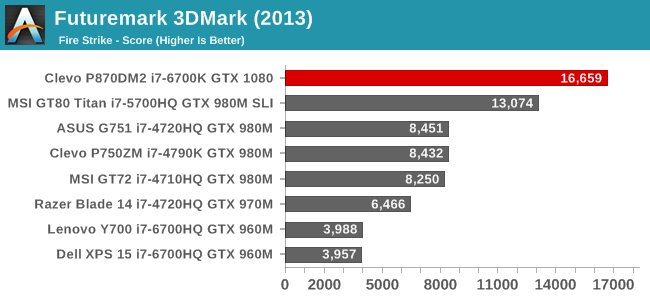
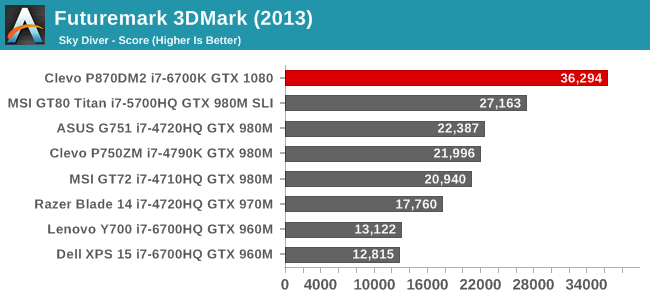
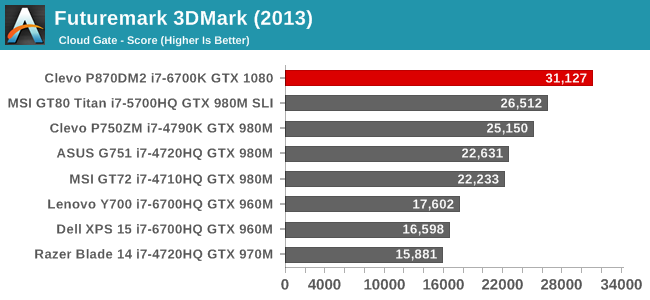

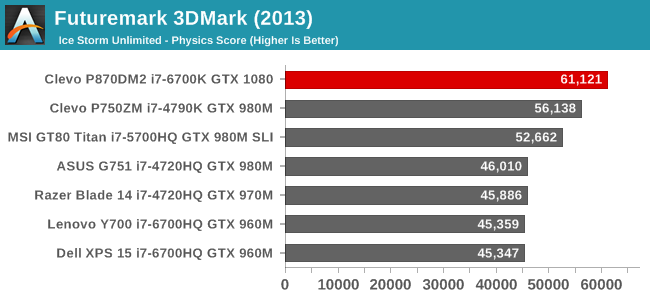
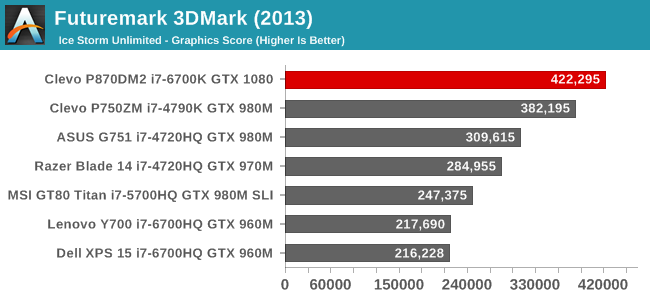
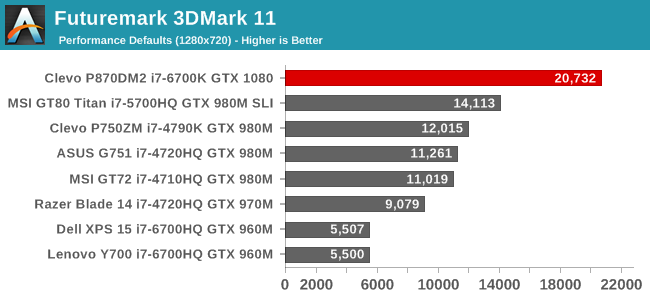
First up is a couple of synthetic tests. Futuremark’s 3DMark is a long-standing graphics test, and makes for an easy comparison across devices. Here it is already apparent just how much of a jump in performance the NVIDIA GTX 1080 is compared to the GTX 980M in the outgoing models. Even the SLI GTX 980M in the MSI GT80 Titan has no chance against a single GTX 1080.
GFXBench

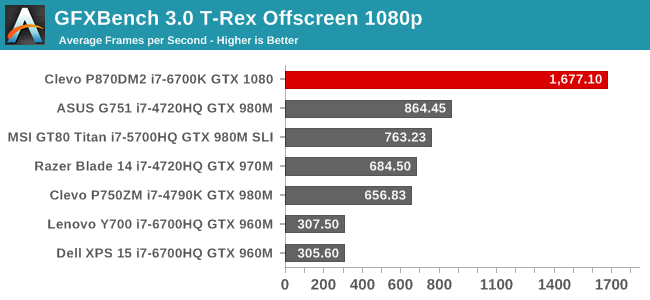
Once there are a couple more data points, we’ll have to move to the newer versions of GFXBench, but this mobile focused test is really not a stress at all on any desktop GPU. Still it’s fun to see just how far these can go, and the GTX 1080 sets a ridiculous score of 1677 frames per second in T-Rex.
Bioshock Infinite
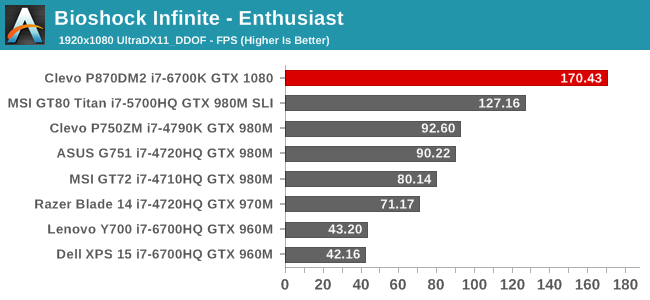
This game is getting a bit long in the tooth, but it has still been a decent notebook benchmark when turned up to Ultra settings. There is also a great amount of data going back many years, which is helpful too. Once again, the GTX 1080 demolishes this test with 170 frames per second on our enthusiast settings.
Dragon Age Inquisition
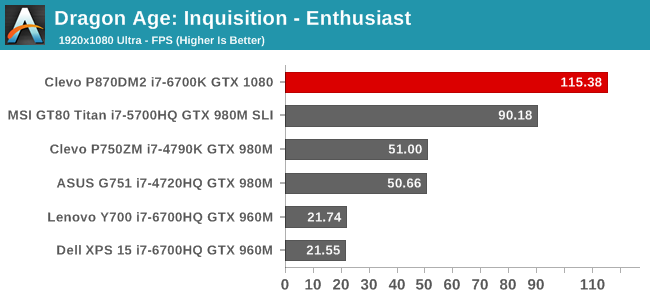
This epic RPG from Bioware is one of my favorite games ever, and at maximum settings it can really punish graphics cards too. At 115 fps, this is the first game to come close to the 120 Hz of the display, but still the gulf between the GTX 980M and the GTX 1080 is gigantic.
GRID Autosport
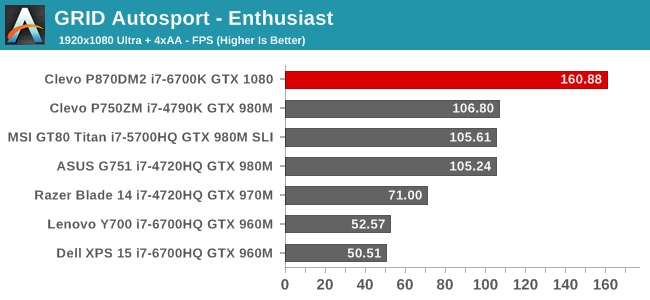
Once again, the giant leap in performance is on display here. GRID is more CPU bound than some other games, at least on the same GPU architecture, but Core i7-6700K with GTX 1080 has no issues.
Shadow of Mordor
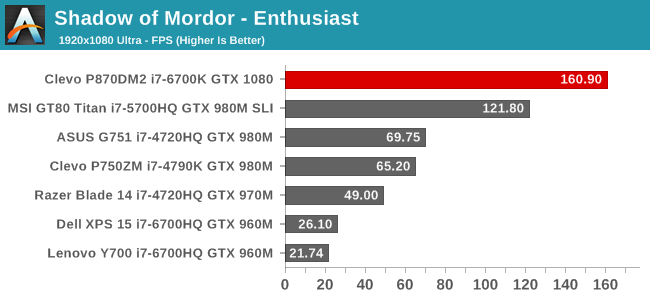
Once again, Shadow of Mordor has been a good test for notebooks, with previous generation devices barely getting an average of 60 FPS on Ultra settings, but the GTX 1080 has no such problems, with the new laptop having a framerate 242% of the GTX 980M in the Clevo P750ZM. The SLI GT80 Titan is a bit closer, but still isn’t in the same league.
Tomb Raider

The original Tomb Raider is such a great game that it would be difficult to see it go, but now with Rise of the Tomb Raider available, once there are some more data points for the new version, the old one will have to be relegated to the history books. This was one of the games that SLI helped a lot on, and you can see that the SLI GTX 980M in the GT80 Titan pulls pretty close to the GTX 1080, but compared to a single GTX 980M in the P750ZM, the GTX 1080 is 225% faster.
Rise of the Tomb Raider


Despite this being a new DX12 game, you can see that the GTX 1080 really has no issues running it at 1920x1080. The Very High settings need a lot of vRAM, and the 4 GB vRAM in the ASUS G751 GTX 980M couldn’t even complete the benchmark on Enthusiast settings, so just to give a generational showing the Mainstream settings of 1600x900 High are also shown.
Dota 2

If you’re a big fan of eSports, or just a fan of online arena battle games, Dota 2 might be the game you play. If so, fret not. The GTX 1080 does pretty well on this game.
Civilization VI

Only just released, Civilization VI is the latest game in the Civilization series. Civ has generally been pretty intense on the CPU, and it appears that is the case again with Civilization VI. No other systems have been tested (yet) but just for some sort of comparison, my desktop with the same CPU, but a GTX 760, would only get about 25 FPS on the Enthusiast settings. 80 FPS is by far the lowest score on any of the gaming tests, but at the same time the game engine is pretty CPU limited. The difference between 1366x768 Medium and 1920x1080 Ultra is not very significant, which is a good indication that the game is limited in a non-GPU way.
GPU Conclusion
Comparing the GTX 1080 to any previous GTX M branded card is going to show, once again, just what a jump the move to 16 nm Pascal is. The GTX 1080 is easily twice as fast, or more, than the GTX 980M. There seems to be a good reason NVIDIA decided to drop the mobile branding, because the gap between notebook and desktop is as small as ever.










61 Comments
View All Comments
BrokenCrayons - Thursday, October 27, 2016 - link
Minor details...the MYTH Control Center shows an image of a different laptop. It struck me right away because of the pre-Pentium MMX Compaq Presario-esque style hinge design.As for Pascal, the performance is nice, but I continue to be disappointed by the cooling and power requirements. The number of heat pipes affixed to the GPU, the fact that it's still reaching thermal limits with such cooling, and the absurd PSU requirements for SLI make it pretty obvious the whole desktop-class GPU in a laptop isn't a consumer-friendly move on NV's part. Sure it cuts back on engineering, manufacturing, and part inventory costs and results in a leaner organization, but it's hardly nice to people who want a little more than iGPU performance, but aren't interested in running up to the other extreme end of the spectrum. It's interesting to see NV approach the cost-cutting measure of eliminating mobile GPU variants and turning it into a selling point. Kudos to them for keeping the wool up on that aspect at least.
The Killer NIC is something I think is a poor decision. An Intel adapter would probably have been a better choice for the end user since the benefits of having one have yet to be proven AND the downsides of poor software support and no driver flexibility outweigh the dubious claims from Killer's manufacturer.
ImSpartacus - Thursday, October 27, 2016 - link
Nvidia just named their mobile GPUs differently.Fundamentally, very little has changed.
A couple generations ago, we had a 780mx that was based on an underclocked gk104. Nvidia could've branded it as the "laptop" 770 because it was effectively an underclocked 770, just like the laptop 1080 is an underclocked 1080.
But the laptop variants are surely binned separately and they are generally implemented on the mxm form factor. So there isn't any logistical improvements just by naming their laptop GPUs differently.
The_Assimilator - Thursday, October 27, 2016 - link
"The number of heat pipes affixed to the GPU, the fact that it's still reaching thermal limits with such cooling, and the absurd PSU requirements for SLI make it pretty obvious the whole desktop-class GPU in a laptop isn't a consumer-friendly move on NV's part."nVIDIA is doing crazy things with perf/watt and all you can do is complain that it's not good enough? The fact that they can shoehorn not just one, but TWO of the highest-end consumer desktop GPUs you can buy into a bloody LAPTOP, is massively impressive and literally unthinkable until now. (I'd love to see AMD try to pull that off.) Volta is only going to be better.
And it's not like you can't go for a lower-end discrete GPU if you want to consume less power, the article mentioned GTX 1070 and I'm sure the GTX 1060 and 1050 will eventually find their way into laptops. But this isn't just an ordinary laptop, it's 5.5kg of desktop replacement, and if you're in the market for one of these I very much doubt that you're looking at anything except the highest of the high-end.
BrokenCrayons - Thursday, October 27, 2016 - link
Please calm down. I realize I'm not in the target market for this particular computer or the GPU it uses. I'm also not displaying disappointment in order to cleverly hide some sort of fangirl obsession for AMD's graphics processors either. What I'm pointing out are two things:1.) The GPU is forced to back off from its highest speeds due to thermal limitations despite the ample (almost excessive) cooling solution.
2.) While performance per watt is great, NV elected to put all the gains realized from moving to a newer, more efficent process into higher performance (in some ways increasing TDP between Maxwell/Kepler/etc. and Pascal in the same price brackets such as the 750 Ti @ 60W vs the 1050 Ti @ 75W) and my personal preference is that they would have backed off a bit from such an aggressive performance approach to slightly reduce power consumption in the same price/performance categories even if it cost in framerates.
It's a different perspective than a lot of computer enthusiasts might take, but I much perfer gaining less performance while reaping the benefits of reduced heat and power requirements. I realize that my thoughts on the matter aren't shared so I have no delusion of pressing them on others since I'm fully aware I don't represent the majority of people.
I guess in a lot of ways, the polarization of computer graphics into basically two distinct categories that consist of "iGPU - can't" and "dGPU - can" along with the associated power and heat issues that's brought to light has really spoiled the fun I used to find in it as a hobby. The middle ground has eroded away somewhat in recent years (or so it seems from my observations of industry trends) and when combined with excessive data mining across the board, I more or less want to just crawl in a hole and play board games after dumping my gaming computer off at the local thrift store's donation box. Too bad I'm screen addicted and can't escape just yet, but I'm working on it. :3
bji - Thursday, October 27, 2016 - link
"Please calm down" is an insulting way to begin your response. Just saying.BrokenCrayons - Thursday, October 27, 2016 - link
I acknowledge your reply as an expression of your opinion. ;)The_Assimilator - Friday, October 28, 2016 - link
Yeah, but my response wasn't exactly calm and measured either, so it's all fair.BrokenCrayons - Friday, October 28, 2016 - link
"...so it's all fair."It's also important to point out that I was a bit inflammatory in my opening post. It wasn't directed at anyone in particular, but was/is more an expression of frustration with what I think is the industry's unintentional marginalization of the lower- and mid-tiers of home computer performance. Still, being generally grumpy about something in a comments box is unavoidably going to draw a little ire from other people so, in essence, I started it and it's my fault to begin with.
bvoigt - Thursday, October 27, 2016 - link
"my personal preference is that they would have backed off a bit from such an aggressive performance approach to slightly reduce power consumption in the same price/performance categories even if it cost in framerates."They did one better, they now give you same performance with reduced power consumption, and at a lower price (980 Ti -> 1070). Or if you prefer the combination of improved performance and slightly reduced power consumption, you can find that also, again at a reduced price (980 Ti -> 1080 or 980 -> 1070).
Your only complaint seems to be that the price and category labelling (xx80) followed the power consumption. Which is true, but getting hung up on that is stupid because all the power&performance migration paths you wanted do exist, just with a different model number than you'd prefer.
BrokenCrayons - Thursday, October 27, 2016 - link
You know, I never thought about it like that. Good point! Here's to hoping there's a nice, performance boost realized from a hypothetical GT 1030 GPU lurking in the product stack someplace. Though I can't see them giving us a 128-bit GDDR5 memory bus and sticking to the ~25W TDP of the GT 730. We'll probably end up stuck with a 64-bit memory interface with this generation.